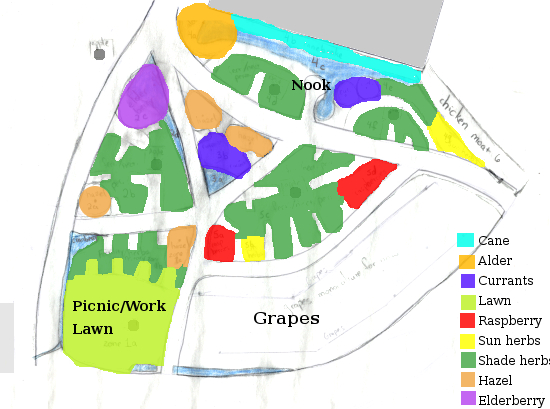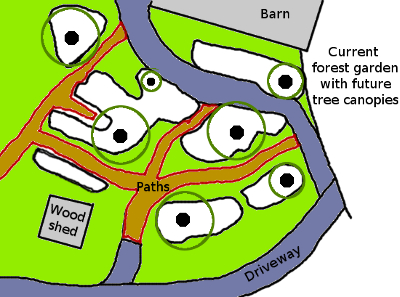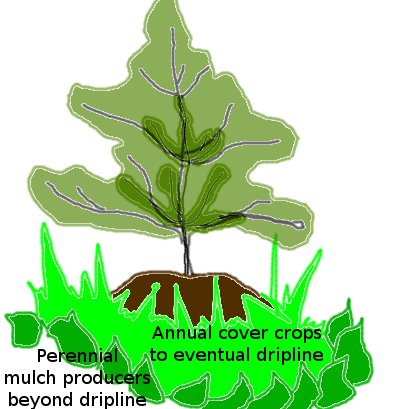
Reinvisioning the forest garden
 A
little less than four years ago, I read Edible
Forest Gardens and
got all fired up. You can read my
ambitious plan from that winter. Now here's what didn't work:
A
little less than four years ago, I read Edible
Forest Gardens and
got all fired up. You can read my
ambitious plan from that winter. Now here's what didn't work:
- The kind of swales I made concentrate rather than drain away water. Luckily, raised hugelkultur planting mounds saved my fruit trees (and created awesome, fungally dominated soil in the process).
- At least while young, the
trees weren't able to compete with dynamic accumulators like comfrey
due to the poor soil on the site. So I changed over to
mulching around the base of each tree, keeping other plantings beyond
the dripline.
- Keyhole beds increase the edge area between beds and paths, which means a lot more weeding if you have grassy aisles. I'm slowly changing over to more linear beds for easier weeding.
 Four years later, the area is
really more of an orchard than a forest garden, but a couple of years
of adding high
value vegetables beyond the trees' root zone has won the troubled
area from the weeds, and I feel ready to start expanding back out into
more diversified plantings. Now I realize that my goals with
non-fruit plantings should be much simpler, focused around building
quality soil as quickly as possible so the trees will have something
other than waterlogged clay to expand their roots into as they grow.
Four years later, the area is
really more of an orchard than a forest garden, but a couple of years
of adding high
value vegetables beyond the trees' root zone has won the troubled
area from the weeds, and I feel ready to start expanding back out into
more diversified plantings. Now I realize that my goals with
non-fruit plantings should be much simpler, focused around building
quality soil as quickly as possible so the trees will have something
other than waterlogged clay to expand their roots into as they grow.
 My new plan is to keep the
soil directly under the current trees' branches completely mulched, at
least until the trees are large enough to handle competition.
Meanwhile, a ring of annual cover crops (buckwheat in the summer, oats,
oilseed radishes, or rye in the winter) will be building soil in the
zone where tree roots will soon be growing. I'll concentrate
perennial mulch producers (like comfrey) beyond the eventual spread of
the tree.
My new plan is to keep the
soil directly under the current trees' branches completely mulched, at
least until the trees are large enough to handle competition.
Meanwhile, a ring of annual cover crops (buckwheat in the summer, oats,
oilseed radishes, or rye in the winter) will be building soil in the
zone where tree roots will soon be growing. I'll concentrate
perennial mulch producers (like comfrey) beyond the eventual spread of
the tree.
Stay tuned for more
specifics on the mulch producers I'm thinking of branching out into in
a later post. Meanwhile, I'd love to hear from others who have
started young forest gardens. Which parts of your book learning
worked and didn't work for you?
Want more in-depth information? Browse through our books.
Or explore more posts by date or by subject.
About us: Anna Hess and Mark Hamilton spent over a decade living self-sufficiently in the mountains of Virginia before moving north to start over from scratch in the foothills of Ohio. They've experimented with permaculture, no-till gardening, trailersteading, home-based microbusinesses and much more, writing about their adventures in both blogs and books.
Want to be notified when new comments are posted on this page? Click on the RSS button after you add a comment to subscribe to the comment feed, or simply check the box beside "email replies to me" while writing your comment.

I planted a couple guilds two years ago...and then we moved, so I don't have a ton of experience yet. I am actively planning my next fruit tree and annual gardens, which will literally be on a forest edge. The hard part is knowing how to orient any swales, as you mention. Do I want to catch the runoff? This area is the natural drainage path from forest to wetland, so drainage might be more important than catchment.
Can't wait to hear about your alternative perennial mulches! I'm leery of comfrey because my food forest is on the edge of some relatively undisturbed forest and fen, and I don't want to introduce something non-native that can't be stopped.
I'm also happy to hear someone point out the shortcomings of "keyhole" gardens. I have had the same trouble with encroaching weeds/grass on all that edge. I've also found that planting annual vegetables in rows within rectangular raised beds is much easier to maintain than offset or totally nonlinear layouts.